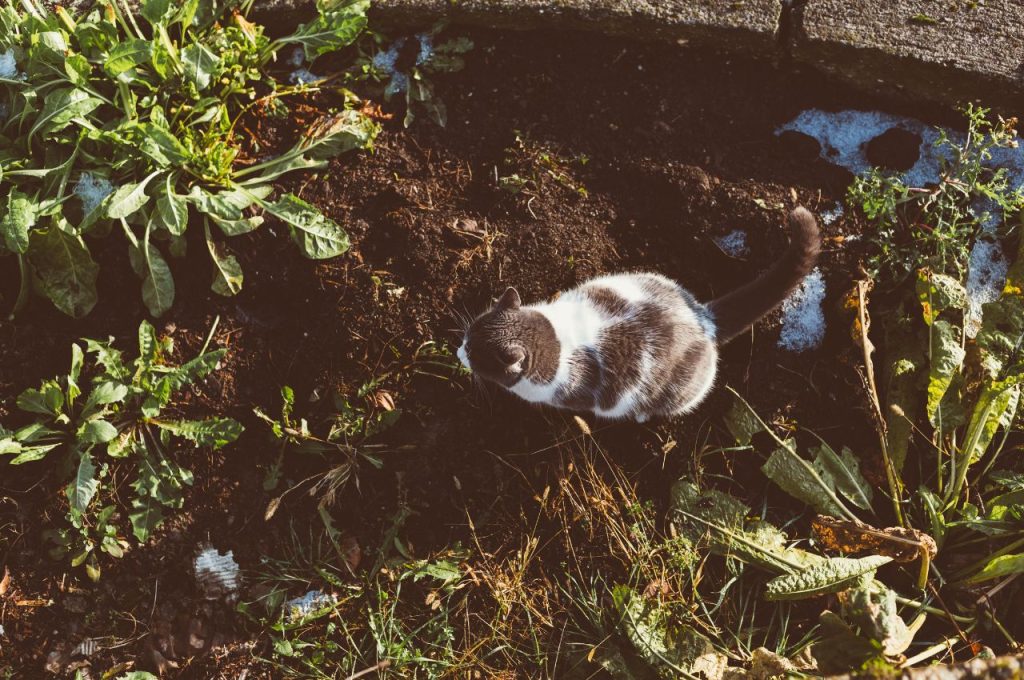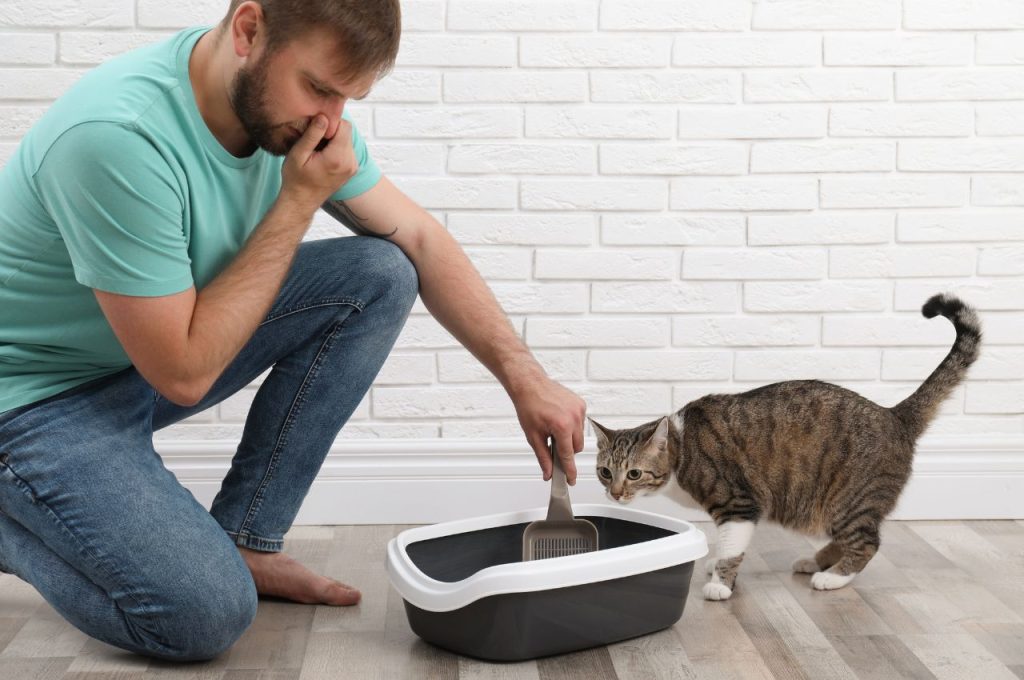To train a cat to use a litter box, start by placing the box in a quiet location and filling it with litter. Encourage the cat to investigate the box by using positive reinforcement, such as treats or praise, and show them how to dig in the litter.
If accidents occur outside the box, clean them up without scolding the cat, and consider placing the cat and the box in a confined area until they consistently use the box. Gradually move the litter box to the desired location, maintain a consistent routine, and provide multiple boxes for multiple cats. Over time, the cat should learn to use the litter box reliably.
Why is Litter Box Training Important For Cats?
Litter box training is crucial for cats to ensure proper hygiene, cleanliness, and ease for both the cat and its owner. By training a cat to use a litter box, you eliminate the mess and odor associated with outdoor elimination and create a designated spot for your cat to do its business indoors.

Litter box training is crucial for cats as it provides them with a designated area to eliminate waste. This not only helps to prevent accidents and messes throughout your home but also ensures the well-being and hygiene of your feline friend. Training your cat to use a litter box has several benefits, which include:
Health Benefits of Using Litter Box
A litter box plays a significant role in maintaining your cat’s health. By providing a clean and appropriate place for your cat to do its business, you can:
- Prevent Urinary Tract Infections: Using a litter box promotes good hygiene and reduces the risk of bacterial infections in your cat’s urinary system.
- Monitor Urine and Fecal Output: By regularly checking the litter box, you can keep track of your cat’s elimination habits and detect any changes that may signal underlying health issues.
- Minimize the Risk of Parasitic Infections: A litter box helps to prevent your cat from coming into contact with potentially harmful parasites or their eggs, which could be present in outdoor soil or dirt.
Preventing Accidents And Messes
Litter box training eliminates the hassle of dealing with unwanted messes around your home. By teaching your cat to use a litter box, you can:
- Avoid Unpleasant Odors: A properly maintained litter box helps to contain and control odors associated with your cat’s waste, ensuring a fresher and more pleasant environment for both you and your pet.
- Protect Your Belongings: Accidents can lead to soiled carpets, furniture, or other household items. Training your cat to use a litter box helps preserve the cleanliness and condition of your home.
- Save Time and Effort on Cleaning: With a litter box, you can easily dispose of your cat’s waste without the need for extensive cleaning or constant vigilance.
Maintaining a Clean and Odor-free Home
A clean and odor-free home is essential for you and your cat’s comfort. Litter box training makes it easier to achieve:
- Easy Waste Disposal: A litter box provides a designated area for your cat to eliminate, making it convenient for you to clean and dispose of the litter regularly.
- Reduced Spread of Bacteria: By confining your cat’s waste to one area, you can minimize the risk of bacterial contamination spreading throughout your home.
- Promote Cats’ Natural Instincts: Cats are naturally inclined to bury their waste as a means of hygiene and marking territory. A litter box satisfies this instinct and prevents them from seeking alternative and potentially unsanitary locations to eliminate.
Getting Started With Litter Box Training
Litter box training is an essential aspect of cat ownership. By teaching your furry friend to use the litter box, you can provide them with a convenient and hygienic spot to do their business. Whether you have a new cat or are looking to retrain an older one, the process can be simple and stress-free if you follow the right steps. In this guide, we will walk you through the key elements of litter box training, starting with choosing the right litter box.
Choosing The Right Litter Box
When selecting a litter box for your cat, consider their size, age, and physical abilities. It’s important to choose a box that they can comfortably get in and out of, without any difficulty. A good rule of thumb is to pick a litter box that is at least one and a half times the length of your cat from nose to tail. This will allow them to move around comfortably while doing their business.
Additionally, consider the depth of the litter box. Cats prefer shallow litter boxes, as they provide easy access and prevent litter from sticking to their paws. Aim for a depth of about 2-3 inches for the litter. If you have a kitten, you might want to start with a shallower box as they may find it easier to navigate.
You may also want to consider the type of litter box. There are various options available, including open-top litter boxes, hooded boxes, and even automatic self-cleaning boxes. Different cats have different preferences, so try to choose a litter box that matches your cat’s personality and needs.
Picking The Appropriate Litter
Once you have chosen the right litter box, the next step is to select the appropriate litter. There are several types of litter available on the market, including clay, clumping, crystal, and natural alternatives. Each type has its pros and cons, so it’s important to consider your cat’s preferences, your preferences, and any specific needs, such as allergies or respiratory sensitivities.
Clay litter tends to be affordable and easy to find, but it may be dusty and not as eco-friendly as other options. Clumping litter is popular for its convenience in cleaning, as it forms clumps around the waste, making it easier to scoop. Crystal litter is known for its excellent odor control, while natural alternatives, such as pine or wheat-based litter, can be environmentally friendly.
Placing The Litter Box in The Ideal Location
The location of the litter box plays a crucial role in successful litter box training. Cats are creatures of habit and prefer privacy when using the litter box, so it’s vital to choose a quiet and secluded area. Avoid high-traffic areas or places where there might be loud noises, as these can startle or disturb your cat.
Place the litter box in an easily accessible spot, away from their food and water bowls. Cats instinctually prefer to keep their toileting area separate from their eating area. Additionally, if you have multiple cats, it’s recommended to have multiple litter boxes placed in different locations throughout your home to prevent territorial disputes.
Introducing Your Cat to the Litter Box
Now that you have chosen the perfect litter box, it’s time to introduce your cat to it. Begin by placing your cat gently into the litter box, ensuring they have a chance to explore and familiarize themselves with it. You can also try using their paws to gently dig in the litter to give them an idea of its purpose.

It’s crucial not to force your cat into the box or punish them if they don’t use it immediately. Instead, observe their behavior and encourage them to use the litter box by praising and rewarding them when they do. If accidents happen outside of the litter box, clean them up without scolding your cat, as negative reinforcement can create anxiety and inhibit their progress.
Remember, patience and consistency are key when it comes to litter box training. With time and positive reinforcement, your cat will soon understand and appreciate their designated spot for toileting.
Encouraging The Cat To Explore The Litter Box
Once you have set up a positive environment for your cat’s litter box, the next step is getting them comfortable with the space. Encouraging exploration will help familiarize your feline friend with the litter box:
- Place your cat near the litter box: gently pick up your cat and place them near the litter box to create awareness and curiosity
- Praise and reward: if your cat shows interest or takes a step toward the litter box, offer verbal praise and a treat as positive reinforcement.
- Allow independent exploration: give your cat some time and space to explore the litter box at their own pace. Avoid forcing them or overwhelming them with attention.
Teaching Cat To Use The Litter Box
Once your cat is comfortable with the litter box and has started exploring it, it’s time to teach them how to use it effectively:
- Place your cat in the litter box: gently pick up your cat and place them inside the litter box after meals, naps, or play sessions. This will help establish a routine.
- Show them how to dig: using your cat’s front paws, simulate digging in the litter to demonstrate the desired behavior. Cats are known to instinctively dig before eliminating.
- Patience is key: wait and observe if your cat starts using the litter box. Be patient and avoid scolding or punishing them if they make mistakes. Positive reinforcement works effectively in this situation.
Addressing Common Litter Box Training Challenges
While litter box training can be relatively smooth for most cats, you may encounter a few challenges along the way. Here are some common issues you may face and how to address them:

| Challenge | Solution |
| Accidents outside the litter box | Ensure the litter box is easily accessible, clean, and the right size. Consider adding additional litter boxes if you have multiple cats. Clean accidents thoroughly to eliminate any lingering odors. |
| Litter aversion | If your cat refuses to use the litter you initially provided, experiment with different textures and scents until you find one they prefer. |
| Stress or anxiety | Stress can impact a cat’s litter box habits. Ensure a peaceful environment, provide ample playtime and attention, and consult a veterinarian if necessary. |
Conclusion
Training your cat to use a litter box doesn’t have to be a daunting task. By following these simple steps and being patient, you can successfully teach your furry friend proper bathroom etiquette. Remember to choose the right type of litter box, provide positive reinforcement, and be consistent with your training. With time and dedication, your cat will learn to use the litter box, giving you and your pet a stress-free and odor-free living environment. Happy training!
